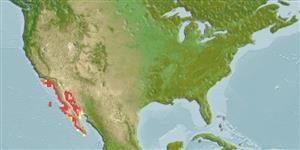Environment: milieu / climate zone / depth range / distribution range
Ecologia
marino demersale; distribuzione batimetrica ? - 46 m (Ref. 2850), usually 3 - 15 m (Ref. 2850). Subtropical; 34°N - 20°N, 121°W - 109°W
Eastern Pacific: California, USA to Baja California, Mexico.
Length at first maturity / Size / Peso / Age
Maturity: Lm ?, range 27 - ? cm
Max length : 45.0 cm TL maschio/sesso non determinato; (Ref. 9118); common length : 30.0 cm TL maschio/sesso non determinato; (Ref. 9118); peso massimo pubblicato: 700.00 g (Ref. 2850); Età massima riportata: 20 anni (Ref. 72462)
Common species found near the bottom, often in caves and crevices of exposed coasts and open bays (Ref. 9118). Feeds on crabs (Ref. 9118).
Eschmeyer, W.N., E.S. Herald and H. Hammann, 1983. A field guide to Pacific coast fishes of North America. Boston (MA, USA): Houghton Mifflin Company. xii+336 p. (Ref. 2850)
IUCN Red List Status (Ref. 130435)
Threat to humans
Harmless
Human uses
Strumenti
Special reports
Download XML
Fonti Internet
Estimates based on models
Preferred temperature (Ref.
123201): 16.7 - 24.2, mean 22.3 °C (based on 110 cells).
Phylogenetic diversity index (Ref.
82804): PD
50 = 0.7500 [Uniqueness, from 0.5 = low to 2.0 = high].
Bayesian length-weight: a=0.00933 (0.00538 - 0.01619), b=3.09 (2.94 - 3.24), in cm total length, based on LWR estimates for this species & (Sub)family-body (Ref.
93245).
Trophic level (Ref.
69278): 3.6 ±0.60 se; based on food items.
Generation time: 6.0 ( na - na) years. Estimated as median ln(3)/K based on 1
growth studies.
Resilienza (Ref.
120179): Medio, tempo minimo di raddoppiamento della popolazione 1.4 - 4.4 anni (K=0.18).
Fishing Vulnerability (Ref.
59153): Moderate to high vulnerability (49 of 100).
